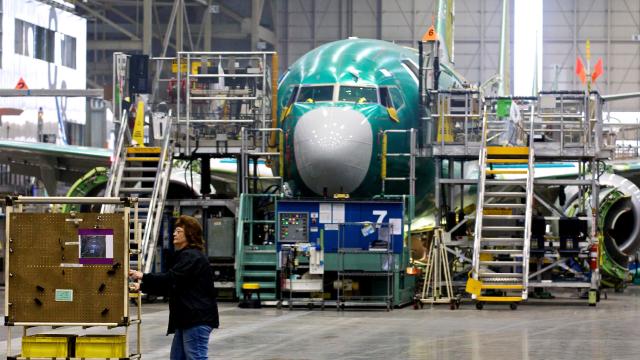Boeing, already having taken a $7 billion after-tax charge this year amid the ongoing fallout from two deadly 737 Max crashes, now has problems with a different line of planes.
Per CNN, the U.S. Federal Aviation Administration is ordering inspections of 737 Next Generation models (737-600, 737-700, 737-800, and 737-900) after Boeing reported that it had discovered certain planes had developed severe “structural cracks.” According to KOMO, the issue is specifically the pickle fork, a critical part that essentially keeps the wings attached to the plane and is designed to withstand the pressure of tens of thousands of takeoffs:
A pickle fork is the part that helps attach a plane’s fuselage to its wing structure. It helps manage the stress, torque and aerodynamic forces that bend the connection between the wings and the body of the jet.
Engineers design pickle forks to last the lifetime of the plane, more than 90,000 landings and takeoffs, a term known as “flight cycles” in the aviation industry, without developing cracks. There could be dire results if the pickle fork system on the jet fails in flight.
BREAKING: Cracks found in critical part (called a pickle fork) that keeps wing attached to 737-NG (not MAX) fuselage. One found earlier in month, now more on other planes. Found early in plane’s lifespan. Boe & FAA scrambling to find extent of problem. @KOMONewsradio #KOMONews pic.twitter.com/iRT4luL5FW
— Charlie Harger (@KOMOCharlie) September 27, 2019
Workers found a cracked pickle fork in one 737 NG plane — at a “relatively young” age of 35,000 flight cycles — and reported it to the FAA, after which inspections turned up similar damage in other 737 NG planes, KOMO reported. A retired engineer told the network, “It’s unusual to have a crack in the pickle fork. It’s not designed to crack that way at all. Period.”
It’s not clear how widespread the issue is, but so far inspectors have only found a “small” number of cracked pickle forks in the 737 NG line, according to the FAA. According to KOMO, “light cracking” is sometimes found in pickle forks but it is considered “very unusual.”
“A crack like this is similar to when you see a crack in a coffee cup handle,” the retired engineer told KOMO. “You can likely continue using the cup several more times, but there’s always a risk that handle will break off and hot coffee will wind up in your lap.”
Both the FAA and Boeing emphasised that the inspection process worked in this instance and repairs would be carried out where necessary.
“Boeing notified the agency of the matter after it discovered the cracks while conducting modifications on a heavily used aircraft,” the FAA told CNN in a statement. “Subsequent inspections uncovered similar cracks in a small number of additional planes. The FAA will instruct operators to conduct specific inspections, make any necessary repairs and to report their findings to the agency immediately.”
Boeing told CNN, “No in-service issues have been reported. Over the coming days, we will work closely with our customers to implement a recommended inspection plan for certain aeroplanes in the fleet. This issue does not affect any 737 MAX aeroplanes or the P-8 Poseidon.”
The two Boeing 737 Max crashes — Lion Air Flight 610 in the Java Sea in October 2018 and Ethiopian Airlines Flight 302 near Addis Ababa in March 2019 — resulted in the deaths of 346 people. The entire 737 Max line was then grounded worldwide and will remain so until Boeing engineers carry out extensive modifications. Those include adjustments to its troubled Manoeuvring Characteristics Augmentation System (MCAS) software, updates to warn pilots of conflicting sensor information, fixes to processor failure that could cause horizontal stabiliser malfunctions, and improved emergency procedures.
The U.S. National Transportation Safety Board recently released a report that concluded the FAA did not properly evaluate MCAS and “variances in pilot behaviour are not being fully considered” during the FAA’s certification process, according to CNN. The NTSB also concluded that Boeing made erroneous assumptions about how pilots would react to flight problems arising from MCAS errors, as well as that test pilots never simulated a situation in which conflicting sensor data caused MCAS to trigger and push a 737 Max’s nose down.
The key finding was that faulty sensor readings combined with erroneous MCAS activation “produced a cascading number of warnings that may have overwhelmed the pilots,” according to the New York Times.
Boeing had insisted that pilots were adequately trained to resolve those issues with standard emergency procedures. American Airlines pilot union spokesman Dennis Tajer disagreed, telling the Times, “They completely discounted the human factor component, the startle effect, the tsunami of alerts in a system that we had no knowledge of that was powerful, relentless and terrifying in the end.”
The FAA has denied another finding by the U.S. Office of Special Counsel that its safety inspectors were underqualified and that it misled U.S. Congress about the issue, according to the Washington Post.
The paper noted that there are multiple ongoing investigations into the crashes, including a U.S. Department of Justice criminal division inquiry, a congressional committee, and a U.S. Department of Transportation investigation.
